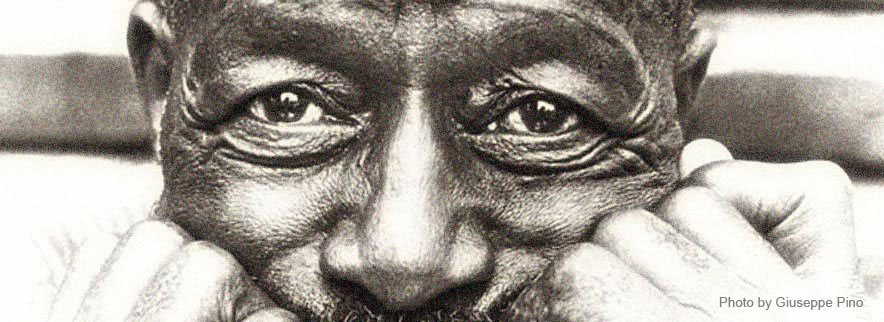In the previous blog, I spent some time on the figure of Son House in his period until the Grafton recording in May 1930. Not really known outside the circle of the blues die hards, his music was nevertheless innovative, and clearly reflected the origins of the blues in spirituals and field hollers. His declamatory, raw performance was intense and full of emotion. He did not just sang the blues, when he performed he was the blues. His work on the guitar was spectacular, and luckily we can find on Youtube some visual testimony of what he did in the sixties.
During the 30ties, Son House had to complement his meagre earnings from performances on picnics, barbecues and in juke joints with manual labour. For a certain period of time he was for instance a tractor driver. The recording session in Grafton had not resulted in any commercial success for Son House, let alone that it brought him any extra bread on the table. Let’s not forget that after all, blues remained a marginal musical phenomenon; it was not mainstream music, and the ‘artists’ were only known locally through their performances for a mainly black, poor public in entertaining environments, which were as full of music, as they were of liquor and women. Blues was dance music, it was played in what were very often private shacks in which during the weekends the few pieces of furniture were put aside to make place for dancing, boozing and gambling. Blues was intimately linked to amusement, sex, women and (illegally produced) booze.
Anyhow, later we will observe that Son House had in those early years of the 30ties a considerable, direct impact on Robert Johnson, who is by many considered as one of the biggest. But that is a different story. Let’s just note here that Robert Johnson as an inexperienced guitarist just fell for the work of Son House, just as the latter had fallen for the work of Willie Wilson. It was after Son House’s mockery of him that Robert Johnson disappeared for a few months to come back as the miracle guitarist and performer as we now know him. Whether he sold his soul to the devil on a crossroad, that is in itself the subject of entire libraries.
In 1941 Alan Lomax was lead to Son House by a certain African American named McKinley Morganfield (better known later on as Muddy Water(s)). Alan Lomax was the son of the great John Lomax, musicologist and folklorist, who was a pioneer in the preservation of American folksongs. Alan continued the work of his father in a passionate way, and blues music was one of his interest fields. His work, which resulted in a few ten thousand folklorist recordings in the American Library of Congress, can simply not be overrated. He went out with his heavy recording equipment of some 150 kilos in a.o. the Delta to record local blues singers in their own environment. Can you see the picture before you of a 25 year old white, progressive looking, boy coming down in those dirty little, hot places only filled with old, wooden shacks in a social environment where the blacks were considered only as work labour, and where the latter could be lynched without any problem just for looking at a white woman? Can you hear the questions that were raised by the local sheriff when this white boy came to enquire about African Americans to record their life story and music? Can you see their suspicion when this boy even named this African American ‘Mister’? Surely, Lomax must have been considered more than once as a complete nut, at the best. Even by the African Americans, his arrival with his small truck full of weird equipment before the shacks was met with the utmost prudency: this white man was surely sent by the FBI or by the fiscal authorities to check on the bootlegging !?
So, McKinley Morganfield, being himself the lucky subject of Lomax’ attention (thanks however in the first place to the fact that Robert Johnson died a few years earlier), also pointed the way to Son House
In that August 1941 Alan Lomax installed his heavy recording equipment in the back of a store, and recorded a few songs by Son House, who was accompanied by a few local musicians. One of them was Willy Brown, his friend, who kept him on the musical tracks during the past years, and who was also present at the Grafton recording session in May 1930. The recordings were purely natural, no audio hocus pocus. Not only was (this portable) recording on wax cylinders difficult, it was also very expensive. There was not much room for re-recording, which is the main reason why on one of the songs the sound of a passing train is heard in the background. If a recording was feasible, it was done out of pure precaution : the originals still had to be transformed in 78-grooves, and this process not always went without problems.
The following year, Lomax came back to Son House, who had testified by his first session of being the real thing, perhaps not as intense as in 1930, but enough to have made a great impression on Lomax. In 1942 Son House performed solo.
The recordings of 1941 and 42 have later, in the 90ties, been technically cleaned for issuing them on CD. These songs belong to the gems of the blues. Note however that Lomax’s were not commercial recordings, but only served a scientific purpose.
Then, Son House just disappeared from the music scene until 1964. A year after the last Lomax session, he moves to Rochester, nearby New York and starts again off with manual labour. In the 50ties, when R&B turns into R&R, he gives up music all together and heads back to his religious life in the Baptist church.

